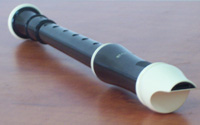Recorder: Difference between revisions
No edit summary |
No edit summary |
||
| Line 4: | Line 4: | ||
[[File:sopraanblokfeluit-bereik.jpg|recorder range]] | [[File:sopraanblokfeluit-bereik.jpg|recorder range]] | ||
A '''soprano'' recorder is in C, and has a range from C5 to D7 - just over two octaves. | A '''soprano''' recorder is in C, and has a range from C5 to D7 - just over two octaves. | ||
The '''alto recorder''' is in F or a quarter lower than the soprano and has a range from F4 to G6 | The '''alto recorder''' is in F or a quarter lower than the soprano and has a range from F4 to G6 | ||
| Line 10: | Line 10: | ||
The '''sopranino''' is a fifth higher than the soprano and also in F with a range from F5 to G7 | The '''sopranino''' is a fifth higher than the soprano and also in F with a range from F5 to G7 | ||
The | The recorders in F - in contrast to music for [[clarinet]]s and [[saxophone]]s - are notated sounding. | ||
If you play the [[ | If you read and play the [[sheet music]] soprano recorder fluently but don't feel like learning new fingerings and you still want to play along on a sopranino, then you can use the soprano recorder fingering by clever [[transposition]]: if it says a C and you play the hold C on a sopranino (or alto), an F will sound. If you turn your music down a quarter ([[transposition]] -5) you cause the opposite. You then read a G, play the grip of a G and a C sounds exactly what you needed! | ||
It can/will happen that the notes fall outside the range of the new instrument, so you have to come up with another list for that (octaves, upper third, sixth), but that's what you have MusiCAD for... | It can/will happen that the notes fall outside the range of the new instrument, so you have to come up with another list for that (octaves, upper third, sixth), but that's what you have MusiCAD for... | ||
==See also== | ==See also== | ||
* [[ | * [[clarinet]] | ||
* [[ | * [[theory]] | ||
[[nl:Blokfluit]] | [[nl:Blokfluit]] | ||
Revision as of 22:10, 14 August 2022
A recorder is a widely used wind instrument (cost little, seems easy).
A soprano recorder is in C, and has a range from C5 to D7 - just over two octaves.
The alto recorder is in F or a quarter lower than the soprano and has a range from F4 to G6
The sopranino is a fifth higher than the soprano and also in F with a range from F5 to G7
The recorders in F - in contrast to music for clarinets and saxophones - are notated sounding.
If you read and play the sheet music soprano recorder fluently but don't feel like learning new fingerings and you still want to play along on a sopranino, then you can use the soprano recorder fingering by clever transposition: if it says a C and you play the hold C on a sopranino (or alto), an F will sound. If you turn your music down a quarter (transposition -5) you cause the opposite. You then read a G, play the grip of a G and a C sounds exactly what you needed!
It can/will happen that the notes fall outside the range of the new instrument, so you have to come up with another list for that (octaves, upper third, sixth), but that's what you have MusiCAD for...


